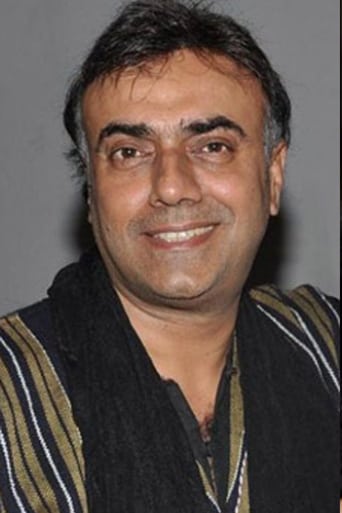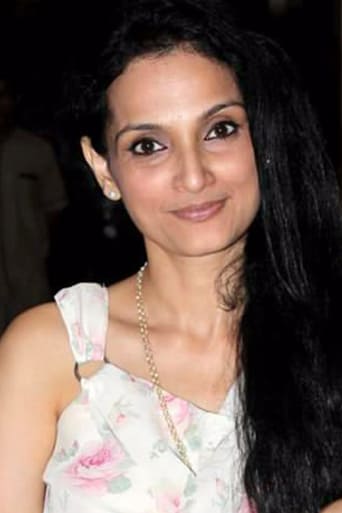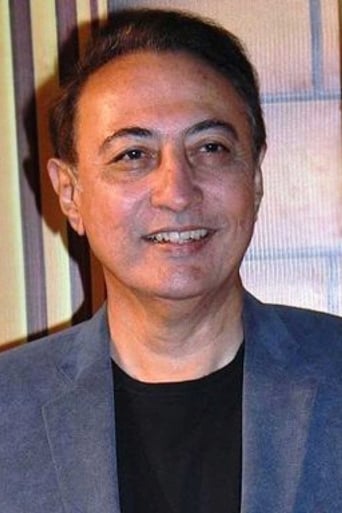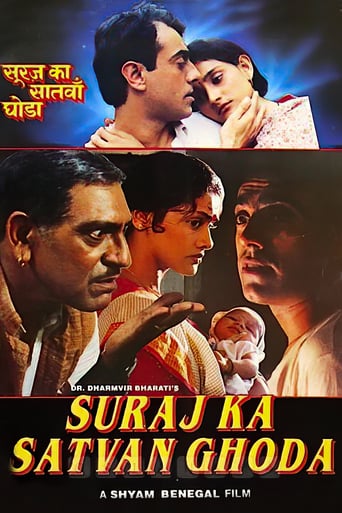
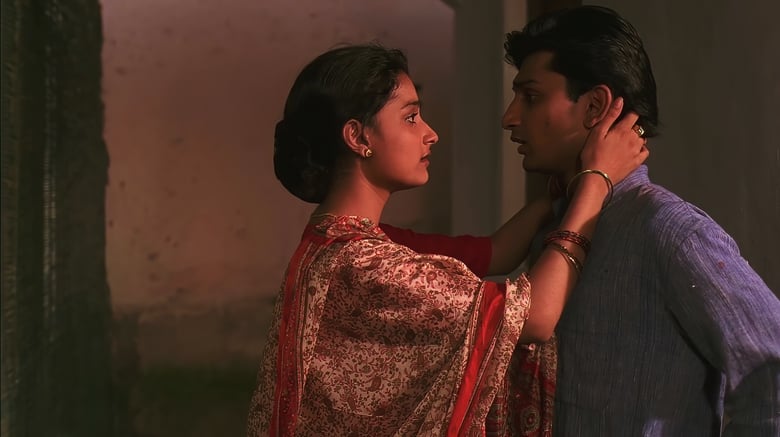
The Seventh Horse of the Sun (1992)
A man shares some lazy memories about his friend, Manek Mulla, who had a knack for telling stories. On this particular afternoon, Manek narrates a 'unique' love affair with the help of different stories, various characters' point of views and the social relevance of these stories. As these stories proceed, reality mixes with fiction.
Watch Trailer
Cast


Reviews
Just what I expected
Fresh and Exciting
best movie i've ever seen.
The best films of this genre always show a path and provide a takeaway for being a better person.
Suraj Ka Saatvaan Ghoda was directed by Shyam Benegal and it's based on the novel of same name written by Dharmveer Bharati. Main roles have been played by Rajit Kapoor, Amrish Puri, Neena Gupta, and Raghuveer Yadav. This is a unique story. If a great story becomes a foundation for a great movie, this is a most significant example of the same. This movie has many outlier features as an Indian movie. Before Memento (2001) I had not seen technique of showing a single scene from many perspectives, but this movie had many such scenes as early as in 1992 when it was made. The narration is multi-layered. The raconteur and prime-protagonist of movie is played by Rajit Kapoor and he has done this with a great degree of refinement. You cannot overlook the fact that theater experience of most of the actors of this movie made it possible to create such fine performances. Shyam Benegal's cast is perfect and I did not find any weaklings in the movie. The usage of regional-dialects in speech along with standard Hindi makes pinch of humor perfectly set in otherwise tragic socio-romantic melodrama. As said earlier, there are many layers to this drama. When one of the characters visits an art gallery, he recalls ( because of one of the paintings in the gallery ) the pastime discussions he used to have along with his other friends, in company of Manik Mulla; where Mulla used to tell them many stories and since Mulla was a literati, his views were considered eminent. In one such discussion, Mulla narrates a few most moving stories which are based primarily on his own romantic affairs and these stories are so interconnected and interwoven that he has to continue telling these until the second day. Inside his stories there are other narrations, making this story a multi-layered complex-threaded story. Mulla tells his listeners many stories which seem different but are interconnected because the same set of characters are present in each of the stories and apart from the social conditions affecting the characters of these stories there are love affairs which permeate from one story to other in an endless-shocking-melodramatic fashion. Mulla is not only the raconteur but also the hero of all of the stories and the witness perspective of all of the stories. There is at least one scene in each of the stories which connects to another scene in the previous story and in the last story the dark side of Mulla is revealed. In the end of the movie Mulla has to cope with what he had done. In spite of characterization of the father of the lover boy in first story as a womanizer, it's Mulla himself who is the most flirtatious character of all. In every story he is playing an escapist coward who flirts until in trouble.This movie is a masterpiece by Shyam Benegal because of his sensible direction and unique style of storytelling. The movie underscores the importance of great literature. The original story written by Dharmveer Bharati was a meta-fiction experiment in 1952.The movie is about Indian social structure and love-affairs getting affected because of lovers like Devdas (You cannot fail to observe mention of Devdas in more than one stories). It was an audacious story by the standards of Indian society of the decade in which it was created. I feel that nobody could have done justice with the role of Mulla more than Rajit Kapur and I think this movie is one of the greatest movies ever made in Indian cinema despite not being one of the most popular.
We, in Denmark, began daylight saving today – March 28, 2010. What this basically means is that our clocks will now be set to an hour ahead. It is curious how this day coincided with my viewing of Shyam Benegal's 'Suraj ka saatwa ghoda' (The seventh steed of the sun) last night. Based on a Hindi novella by the same name by Dr. Dharamvir Bharti's, the movie starts with Raghuvir Yadav introducing us to a few afternoons from his life where he knew a man called Manek Mulla (Rajit Kapur in his debut venture). Manek, we are told, was a master story-teller. A man who could blur out the distinct lines between reality and fiction purely by his talent at peppering his tales with metaphors aplenty. Working with the railways department, Manek had acquired the knack of keeping the three young men (of which Yadav is one too) occupied during lazy afternoons with his tales of love, deception, social imbalance and immorality within the lower middle classes of India.So, with this premise, a question is thrown – 'Should love stories be built at being relevant to the socio-economic growth of a society?' A bizarre, albeit thought-provoking, reference is made to the literary importance of 'Devdas' where, Manek says, there is no room for any sort of social relevance or optimism towards love as a public emotion. A definition, he claims, is what makes love so wonderful. Its lack of being a private, mysterious and almost forbidden concoction. So, in an effort to tell a tale of love lost connected with the complex fabric of social strata, he starts speaking of Jamuna. He speaks of how he was in school back then and Jamuna, the attractive next door girl, was in love with Tanna, another neighborhood fellow. Jamuna's and Tanna's love story was dated given the venomous relationships the two families shared due to lack of consistency in the Indian economic balance. As a result of this, Tanna is married off to a more educated Lily and Jamuna ends up with an old man knocking on the door of his grave.As you might have realized, there is nothing new or refreshing with this piece. What starts making this short story more interesting, is the way Manek describes his role in it and carefully begins to uncurl the tiny strands that were knotted during the narration of the aforementioned tale. For instance, the fact that Jamuna is unable to conceive from her old-man husband and so chooses to go on a bizarre religiously aligned but emotionally maligned detour with the tonga-wallah is brought to surface. Also, the fact that the girl Tanna ends up with – Lily – actually was Manek's love/friendship interest and how a mutual separation was finalized in both their interests is unearthed. Connected to this colorful mix as well, is the story of Tanna's lusty father (Amrish Puri in a truly memorable role as Mahesar Dalal) and his wile desires towards the lowly gypsy-woman Satti (Neena Gupta) who befriends Manek purely for his intellectual skills. Her eventual fate against an adamant Mahesar Dalal and the decisions young Manek makes form the twisting portions of the climactic sequences. All of these is documented from various angles aimed at the same scene. So, it isn't so much that Manek is narrating different short stories but essentially narrating just one story but from the perspectives of various characters in them. In some of them, the characters seem like the victims, while when seen from the view of another person's tale, the same character in the same scene will suddenly appear to have acquired some gray shades. Shades one would see in a predator. Truly – if a movie can accomplish this level of intellectual worth, then it has truly defined itself as the best example of cinema.What makes this movie greater in its worth is the fact that such a unique feat was written by Dr. Bharti in the 70s and narrated by Benegal in early 90s! Today we sit in awe at the intermingling of multiple stories in Hollywood and, of course, in their remade versions within Bollywood, and applaud them as being 'masterpieces'. But to compare this work to any of these would be nothing short of a huge disservice. In fact, I would call 'Suraj ka...' a work of meta fiction which successfully attempts to expose the fictional aspect of the illusive world woven by Manek Mulla.I also read some reviews that compared Manek's character to that of the holy trinity in Hindu mythology – Brahma, Vishnu and Maheshwar – and as to how he slips into these roles, albeit with varying degrees of subtlety. In the first tale with Jamuna, Manek is Brahma, the creator of a relationship that he knew was meant to be doomed. In the second tale with Lily, he became Vishnu, the preserver of her sanctity and an upholder of a more mature and practical relationship. In the final tale with Satti, he turned into the destroyer – Maheshwar – who ended up putting an end to what could have possibly been the redeeming factor of his life. I suppose it is in spectacular interpretations like these, that 'Suraj ka...' stands out as a truly unique piece of work.
Manik Mulla (played by Rajit Kapoor) mesmerizes his listeners with his thoughts about love being disciplined on economic restrictions. The direction is mind blowing . The way the stories are connected is just superb, every story portrays manik mulla as central character , how his life takes shapes as he comes across three girls at different stages of his life... In the end there are definite conclusions (with little socialist angle ) The language in the movie is so pure and serene , it inspires to learn Hindi vocab. I have seen this movie several times .. there is a nice song in it too..A must see if you like art movie , I bet you will fall in love with the characters as you see them.
Shyam Benegal directs this 1993 film based on Bharti's Hindi novel. The highly experienced cast and talented production team manage to cook up a rich tapestry of semi-dream-like experiences of a young man, entering into adulthood. Using a story-teller mosaic, the narrator (Rajat Kapur) goes back and forth over the lives of 3 women whom he was involved with in his high-school and early college.Simple-minded country bumpkins do lead colorful complicated lives filled with drama and intensity. Surely but occasionally. Mostly not as it is shown here. There's somewhat of a mismatch between the rural atmosphere and the refined, educated, urbane, clean-cut protagonist. That cavalier attitude of his ('Look, I've arrived') doesn't give it away, rather it only serves to confound. Benegal conditions you from the very start not to expect great drama until the very end. Watching the dead-pan account with an equally dead-pan expression is all you can do. Use of purist as opposed to colloquial Hindi fails to have the desired effect. Could be due to Benegal's early background in documentaries for Films Division, NFDC, 'Door'darshan, et al.If one watches such movies at a theater, it will either be mostly empty to start with, or mostly empty within 10 min., or most certainly mostly empty halfway thru i.e you can sit anywhere post-interval and munch on your popcorn. Audiences thumb it down, and the producers foolishly tell themselves its because viewers are illiterate, they don't get it, etc. No doubt the screenplay, direction, photography, etc are all top-notch. But if there's no drama and not much entertainment, why blame viewers? Style alone can't substitute for substance.The movie made no ripples at the box-office and disappeared without a trace (can't blame that on Shahrukh-Madhuri). Left a lot to be desired by way of suggestibility (not suspense, go figure!)


